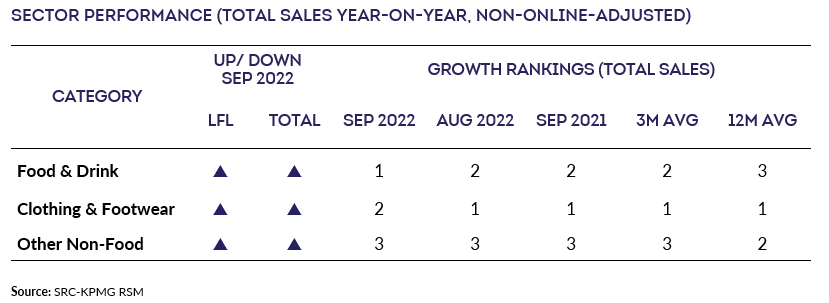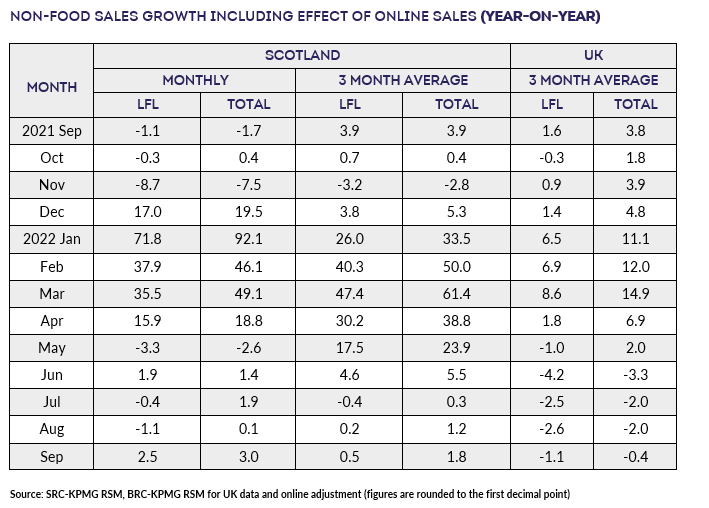Sales figures are not adjusted for inflation. Given that both the
September SPI (BRC) and August CPI (ONS) show inflation running
at historically high levels, a portion of the sales growth will
be a reflection of rising prices rather than increased volumes.
Covering the five weeks 28 August – 1 October
2022
- Total sales in Scotland increased by 6.5% compared with
September 2021, when they had grown 1.3%. This was above the
3-month average increase of 5.8% and below the 12-month average
growth of 15.7%. Adjusted for inflation, the year-on-year change
was 0.8%.
- Scottish sales increased by 4.2% on a Like-for-like basis
compared with September 2021, when they had increased by 1.1%.
This is above the 3-month average increase of 3.3% and below the
12-month average growth of 12.4%.
- Total Food sales increased by 9.6% versus September 2021,
when they had increased by 0.4%. September was above the 3-month
average growth of 8.5% and the 12-month average growth of 2.2%.
The 3-month average was above the UK level of 4.6%.
- Total Non-Food sales increased by 3.9% in September compared
with September 2021, when they had increased by 2.1%. This was
above the 3-month average increase of 3.5% and below the 12-month
average of 27.1%.
- Adjusted for the estimated effect of Online sales, Total
Non-Food sales increased by 3.0% in September versus September
2021, when they had decreased by 1.7%. This is above the 3-month
average growth of 1.8% and below the 12-month average of 18.5%.
Ewan MacDonald-Russell, Deputy Head | Scottish Retail
Consortium
“Scottish sales showed a sliver of growth in September, with a
real terms rise of 0.8 percent. Nonetheless, there are clear
signs customers are battening down the hatches ahead of the
expected winter costs crunch. Food sales fell in real terms as
customers cut back on the volume of goods. With food inflation
now outpacing sales even grocery retailers are feeling the
pressure as customers focus on essential items.
“Non-food sales were dominated by consumers looking for ways to
reduce their energy bills. Duvets, blankets, and air fryers all
did well as customers look to cut costs and prepare for
winter. These are not propitious signs for retailers as
they enter the golden trading quarter. With customers focusing on
essentials, it will be a real challenge to encourage shoppers to
splash out on Christmas gifts. Government need to keep a
watchful eye on this and be prepared to take action in upcoming
fiscal announcements to support retailers facing into the teeth
of intense cost challenges. “
, Partner, UK Head of
Retail | KPMG
“Despite Scottish retail sales growing
in September, high levels of inflation wiped out signs of real
terms growth, and unfortunately, tougher times are ahead.
Consumers were more cautious last month, avoiding large ticket
items as many households prepared for higher energy costs through
the winter, evidenced by a spike in warm clothes purchases during
September.
“With interest rates, inflation, labour, energy and cost of goods
continuing to climb, retailers are heading into one of the most
challenging Christmas shopping periods they have had to deal with
in years. Consumer confidence remains low, and retailers
are having to tread a very fine line between protecting their own
margins and further denting confidence by passing on price
rises. A laser focus on their own costs and efficiencies in
order to remain price competitive this festive season will be
essential. As consumers focus on getting value for money
through switching to own brand items and seeking out discounts,
getting pricing and promotional activity right could be the
difference between a successful or dismal Christmas for retailers
this year.”



